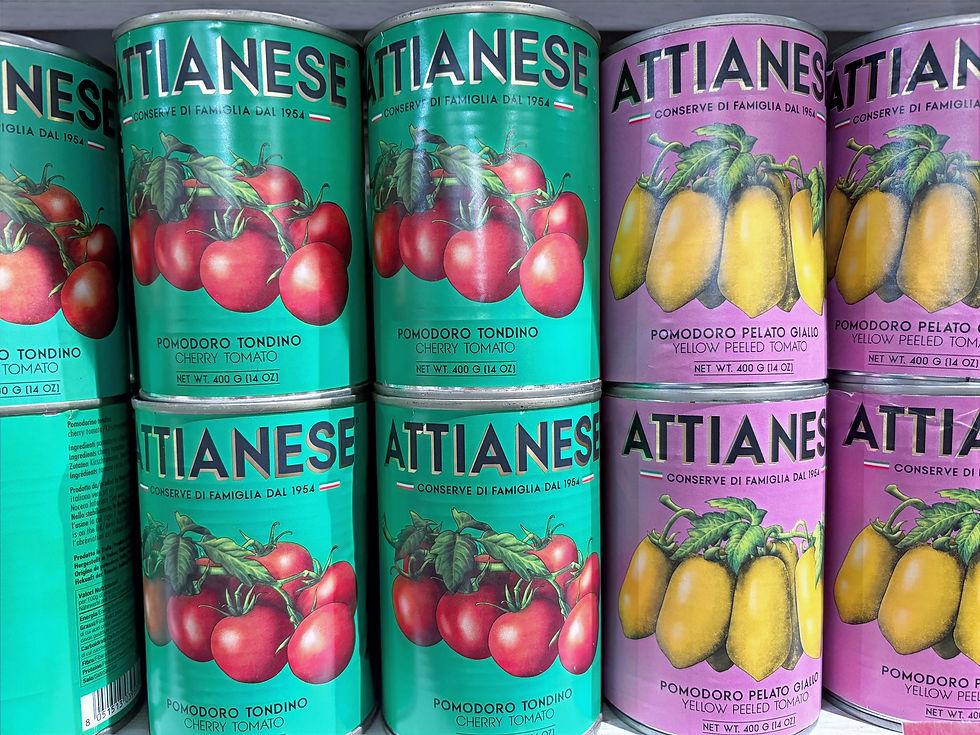Vegetables of Italy: San Marzano Tomatoes and the Art of Preserving Sunshine
- Made al Dente

- Jul 4
- 4 min read
Updated: Jul 12

In the deep swell of July, when the Italian sun presses itself into every leaf, tile, and stone, there is a scent that rises from the fields around Naples — green and sweet, with a breath of earth. It is tomato season. Not just any tomatoes, but San Marzano, the long, tapered fruit with thin skin and a low seed count, hanging in clusters like red lanterns. In rural Campania, grandmothers gather crates of them by the kilo, preparing for the annual rite of la conserva: the great tomato bottling.
It is more than tradition. It’s choreography — steam clouding the kitchen windows, boiling water burbling in deep pots, a chorus of hands peeling, passing, ladling. And when the jars are sealed and tucked away in cool, dark cupboards, they carry with them a promise: of sauce in January that still tastes like August. San Marzano is not merely an ingredient. It is the memory of summer, preserved.
San Marzano - A Tomato with Deep Roots
The San Marzano tomato is believed to have first taken root in Italian soil in the 18th century, possibly introduced from Peru. But what followed was not just adaptation — it was transformation. Over generations, it became intrinsically tied to the Agro Sarnese-Nocerino, a fertile plain in the shadow of Mount Vesuvius. Here, the combination of volcanic soil, coastal breezes, and deep aquifers shaped the fruit’s unique character.
Though once met with suspicion, tomatoes grew to become central to Italian cuisine. By the 19th century, San Marzano had emerged as a favorite for sauce-making — prized for its low acidity, sweet flesh, and meaty texture. In modern times, the name is protected: only tomatoes grown and processed in this region according to strict standards may bear the label San Marzano dell’Agro Sarnese-Nocerino DOP.
How They’re Grown and Preserved
San Marzano tomatoes are typically staked as they grow, with careful attention to spacing, sun exposure, and water regulation. Their cultivation is still highly manual and seasonal, with hand-harvesting beginning in late July and continuing into early autumn.
For DOP certification, the tomatoes must be:
Grown within the designated region
Picked at full ripeness
Handled and transported in ventilated crates
Peeled, packed whole, and preserved with minimal ingredients — usually just juice and a basil leaf
Industrial bottling and traditional home preserving follow similar rhythms, albeit at different scales. In homes across Campania, families gather to boil, peel, and bottle fresh tomatoes — a practice passed down for generations.
What Makes the Flavor Unique
What sets San Marzano apart is its clean, balanced sweetness — rich without being overpowering. It has:
Low water content, yielding thicker sauces
Few seeds, minimizing bitterness
Thin skin, which peels easily
A delicate acidity, making it ideal for slow simmering
Unlike juicy slicing tomatoes or tart cherry varieties, San Marzano is meant to be cooked. Its flavor deepens with heat, mellowing into something round and savory — the backbone of countless Italian dishes.
A Ritual in the Kitchen
In southern Italy, fare la conserva is not just culinary — it is cultural. Every summer, families dedicate entire weekends to tomato bottling, often in communal spaces like patios or garages. Children learn by watching, then by helping: placing basil, tightening lids, tasting the warm sauce.
This act of preservation is a living connection to the land and the past. It embodies the Italian reverence for seasonality, self-reliance, and the celebration of simplicity.
And beyond the home, San Marzano is woven into iconic dishes — from pizza napoletana (where it's the sauce base) to pasta al pomodoro, where the tomato’s unadorned brilliance shines.
Best Ways to Use San Marzano
San Marzano tomatoes are rarely eaten raw. Their strength lies in how they transform with cooking. Popular preparations include:
Sugo al pomodoro: Classic tomato sauce with garlic, olive oil, and basil
Neapolitan pizza sauce: Often crushed and used raw, letting the tomato speak for itself
Shakshuka or eggs in purgatory: Poached eggs in a lightly spicy San Marzano base
Ragù napoletano: A slow-cooked meat sauce where tomatoes melt into richness
For best results, use them whole and peeled, either crushed by hand or simmered gently. Their sweetness means less sugar or salt is needed.
Other Plum Tomatoes Across Italy
While San Marzano dominates in Campania, other regions grow plum-style tomatoes with distinct qualities:
Variety | Region | Notable Features |
Piennolo del Vesuvio | Campania | Small, sweet, often dried in hanging bunches |
Roma | Lazio, Central Italy | More acidic, used in canned goods |
Datterino | Sicily, Apulia | Tiny, sugar-sweet, eaten fresh or cooked |
Costoluto Fiorentino | Tuscany | Ribbed and juicy, ideal for slicing raw |
Each tomato tells its own story — but none quite rival the global renown and legal protection of the San Marzano.
What to Know Before You Cook
Buy certified: Look for Pomodoro San Marzano dell’Agro Sarnese-Nocerino DOP on the label.
Choose whole, peeled tomatoes in juice — not diced or pureed, which may include additives.
Avoid over-seasoning: Let the natural flavor lead; a touch of oil and basil is often enough.
Store opened cans in glass, not metal, and refrigerate for up to 3 days.
Test with a spoon: If it tastes like summer straight from the jar, you’ve found the real thing.
The Taste of Sunlight, Even in Winter
There’s a quiet magic in lifting the lid from a jar of preserved San Marzano tomatoes in the heart of winter. The scent is immediate — sun-warmed vines, crushed basil, humid fields. In a world chasing shortcuts, San Marzano offers a patient alternative: flavor born of season, soil, and care. It reminds us that summer can be bottled — and that some ingredients carry not just taste, but time.


